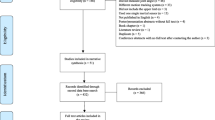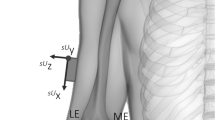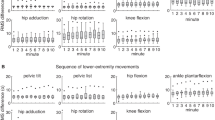Abstract
The objective of this study was to determine the accuracy of custom designed wearable sensors when compared to a robotic device to measure i) peak angles in a single plane (flexion/extension) and ii) the extent of error associated with speed of movement. Two experimental procedures were undertaken; i) one wearable sensor was mounted on the arm of a step motor that simulated wrist flexion/extension at the speed of 90°/s with the other wearable sensor static (flat surface); and ii) two wearable sensors were each mounted on a step motor which was programmed to move at two movement speeds 30°/s and 90°/s. When compared to pre-determined angles of the robotic device, the wearable sensors detected peak angles with mean error ranging from -0.95° to 0.11° when one wearable sensor was static and the other dynamic. When two wearable sensors were moving, movement at the higher speed (90°/s) had a mean error range of -2.63° to 0.54, and movement at the slower speed (30°/s) had a mean error range of -0.92° to 2.90°. The custom wearable sensors demonstrated the ability to measure peak angles comparable to the robotic device and demonstrated acceptable to reasonable error when tested at two movement speeds. The results warrant future in vivo testing.

Similar content being viewed by others
Abbreviations
- 3DMA:
-
Three-Dimensional Motion Analysis
- WS:
-
Wearable sensor
- SD:
-
Standard deviation
- RMS error:
-
Root mean square error
- DOF:
-
Degree of freedom
References
Saber-Sheikh K, Bryant EC, Glazzard C, Hamel A, Lee RYW. Feasibility of using inertial sensors to assess human movement. Man Ther. 2010;15(1):122–5.
Gajdosik RL, Bohannon RW. Clinical measurement of range of motion: Review of goniometry emphasizing reliabiliy and validity. Phys Ther. 1987;67(12):1867–72.
Stuberg WA, Fuchs RH, Miedaner JA. Reliability of goniometric measurements of children with cerebral palsy. Dev Med Child Neurol. 1988;30(5):657–66.
Besier TF, Sturnieks DL, Alderson JA, Lloyd DG. Repeatability of gait data using a functional hip joint centre and a mean helical knee axis. J Biomech. 2003;36(8):1159–68.
van den Noort JC, Ferrari A, Cutti A, Becher JG, Harlaar J. Gait analysis in children with cerebral palsy via inertial and magnetic sensors. Med Biol Eng Comput. 2013;51(4):377–86.
Bisi MC, Stagni R, Caroselli A, Capello A. Anatomical calibration for wearable motion capture systems: Video calibrated anatomical system technique. Med Eng Phys. 2015;37(8):813–9.
Zhou H, Hu H. Tao. Inertial measurements of upper limb motion. Med Biol Eng Comput. 2006;44(6):479–87.
Tao Y, Hu H, Zhou H. Integration of vision and inertial sensors for 3D arm motion tracking in home-based rehabilitation. Int J Robot Res. 2007;26(6):607–24.
Bouvier B, Duprey S, Claudon L, Dumas R, Savescu A. Upper limb kinematics using inertial and magnetic sensors: Comparison of sensor-to-segment calibrations. Sensors. 2015;15(8):18813–33.
Roetenberg D, Luinge HJ, Baten C, Veltink PH. Compensation of magnetic disturbances improves inertial and magnetic sensing of human body segment orientation. IEEE Trans on Neural Syst Rehab Eng. 2005;13(3):395–405.
Walmsley CP, Williams SA, Grisbrook T, Elliott C, Imms C, Campbell A. Measurement of upper limb range of motion using wearable sensors: A systematic review. Open Access J Sports Med. 2018;4(53):1–22.
Alvarez D, Alvarez JC, Gonzalez RC, Lopez AM. Upper limb joint angle measurement in occupational health. Comp Methods in Biomech and Biomed Engin. 2016;19(2):159–70.
Ricci L, Taffoni F, Formica D. On the orientation error of IMU: Investigating static and dynamic accuracy targeting human motion. PLoS One. 2016;11(9):1–15.
Chang HT, Cheng LW, Chang JY. Development of IMU-based angle measurement system for finger rehabilitation: 23rd International Conference on Mechatronics and Machine Vision in Practice (M2VIP), Nanjing; 2016.
Côrrea D, Balbinot A. Accelerometry for the motion analysis of the lateral plane of the human body during gait. Heal Technol. 2011;1(1):35–46.
El-Gohary M, McNames J. Human joint angle estimation with inertial sensors and validation with a robot arm. Biomed Eng. 2015;62(7):1759–67.
Ng L, Burnett A, Campbell A, O’Sullivan P. Caution: The use of an electromagnetic device to measure trunk kinematics on rowing ergometers. Sport Biomech. 2009;8(3):255–9.
Xu W, Ortega-Sanchez C, Murray I. Measuring human joint movement with IMUs: Implementation in low cost wireless sensors: IEEE Student Conference on Research and Development (SCOReD), Putrajaya, Malaysia; 2017.
Schiefer C, Ellegast RP, Hermanns I, Kraus T, Oschsmann E, Larue C, et al. Optimization of inertial sensor-based motion capturing for magnetically distorted field applications. J Biomech Eng. 2014;136(12):121008–8.
McGinley JL, Baker R, Wolfe R, Morris ME. The reliability of three-dimensional kinematic gait measurements: A systematic review. Gait Posture. 2009;29:360–9.
Alvarez D, Alvarez JC, Gonzalez RC, Lopez AM. Ambulatory human upper limb joint motion monitoring. IEEE Int Instrum and MeasTech Conference, Graz, Austria; 2012.
dos Santos CM, Ferreira G, Malacco PL, Moraes GFS, Felicio DC. Intra and inter examiner reliability and measurement error of goniometer and digital inclinometer use. Rev Bras Med Esporte. 2012;18(1):38–41.
Zhou H, Hu H. Reducing drifts in the inertial measurements of wrist and elbow positions. IEEE Trans Instrum Meas. 2010;59(3):575–85.
Acknowledgements
This research was completed with support from the Australian Government Research Training Program Scholarship and Perth Children’s Hospital Foundation. A grant was awarded from the Australian Catholic University to fund the development of the wearable sensors.
Author information
Authors and Affiliations
Corresponding author
Ethics declarations
Disclosure of potential conflicts of interest
Author CE holds a position at Perth Children’s Hospital, and CI is employed by the Australian Catholic University. The authors declare that neither the Australian Catholic University nor the Perth Children’s Hospital Foundation had a role in the conduct of the research or the reporting or interpretation of results.
Ethical approval
Ethical approval was not required.
Informed consent
This study did not include human participants and therefore informed consent is not applicable.
Conflict of interest
The authors declare that they have no conflict of interest.
Additional information
Publisher’s note
Springer Nature remains neutral with regard to jurisdictional claims in published maps and institutional affiliations.
Rights and permissions
About this article
Cite this article
Walmsley, C.P., Xu, W., Ortega-Sanchez, C. et al. Validation of custom wearable sensors to measure angle kinematics: A technical report. Health Technol. 9, 887–892 (2019). https://doi.org/10.1007/s12553-019-00360-1
Received:
Accepted:
Published:
Issue Date:
DOI: https://doi.org/10.1007/s12553-019-00360-1




